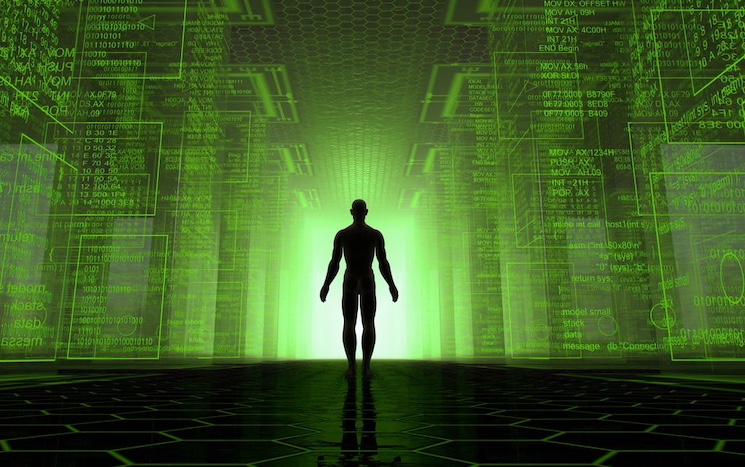
Scientists have dropped a bombshell, asserting with 99.9% certainty that humans are already living in a Matrix-like simulation. This isn’t just sci-fi fantasy—experts argue that our reality, Earth, and the entire universe might be a colossal holographic projection, echoing the iconic film’s premise.
This mind-bending theory could unravel some of physics’ toughest mysteries, from the fate of someone tumbling into a black hole to the universe’s state post-Big Bang. Professor Marika Taylor, a theoretical physicist at the University of Birmingham, supports this by suggesting the universe is fundamentally two-dimensional, challenging everything we think we know about existence.

BYPASS THE CENSORS
Sign up to get unfiltered news delivered straight to your inbox.
You can unsubscribe any time. By subscribing you agree to our Terms of Use
Dailymail.co.uk reports: However, just like when you watch a 3D movie on a flat screen, the images on that 2D surface appear to have depth because of how they are projected onto it.
WEF Scientists Creating Lab-Grown Children Designed For Sex With Pedophiles
So, while you might see the world around you as a complex three-dimensional structure, Professor Taylor claims this is only an illusion.
That doesn’t mean our lives or the universe are any less real, but it does mean that the cosmos might be a lot stranger than we had previously thought.
When you think of the universe being a hologram, you might imagine the projected images from Star Wars or ABBA Voyage.
Although this is the right basic idea, it’s not quite the same type of hologram that physicists are thinking of.
The idea that the universe is a hologram doesn’t have anything to do with light or projectors as the name might suggest.
In scientific language, a hologram is a two-dimensional surface which appears to have a third dimension – like the holographic images on some credit cards.
Since holograms appear three-dimensional you can move around them and see different parts of the image as if there were a real object there.
However, if you reached out to touch one your hand would find only a flat surface.
Scientists like Professor Taylor argue that the whole universe is just like this – a two-dimensional surface that just looks like it has three dimensions.
Instead of the universe being like a solid block, Professor Taylor says we should think of it as more like a hollow ball.
Our solar systems and galaxies are contained inside the ‘3D’ space inside the ball, but the actual surface structure of the universe only has two dimensions.
According to the ‘holographic principle’, we can describe the gravitational movements of the planets and stars within the ball just by talking about what’s happening on the two-dimensional surface.
Although that might seem utterly bonkers, scientists maintain that turning our world on its head isn’t necessarily a problem.
Professor Taylor says: ‘It is very hard to visualise this. However, it is also quite hard to visualise what happens inside an atom.
‘We learned in the early twentieth century that atoms follow quantum rules, which are also quite different from our everyday reality.
‘Holography takes us into an even more extreme world, where not only are the forces quantum in nature, but the number of dimensions is different from our perceived reality.’
One of the biggest misconceptions about the holographic theory is that it means the universe isn’t real or that we are in some sort of simulation.
Although the holograms we are familiar with are always projected by someone and can be turned on or off at will, that isn’t what scientists are saying about the universe.
Professor Taylor says: ‘The Matrix movies are very thought-provoking but probably don’t quite capture all the ideas in holography.’
Likewise, Fermilab, a United States Department of Energy particle physics laboratory, says that the notion of the universe as a ‘simulation’ can be misleading.
Fermilab writes: ‘The notion that our familiar three-dimensional universe is somehow encoded in two dimensions at the most fundamental level does not imply that there is anybody or anything “outside” the two-dimensional representation, “projecting” the illusion or “running” the simulation.’
That means we don’t need to worry about being in any kind of Matrix-like simulation even if the universe is holographic.
Similarly, one of the consequences of the holographic principle is that features of the universe like the third dimension and gravity aren’t a fundamental part of reality.
However, that doesn’t mean scientists are saying these aren’t real.
Instead, physicists say that gravity and the higher dimensions are ’emergent’ properties.
Professor Kostas Skenderis, a mathematical physicist from the University of Southampton, says you can think about this in the same way as temperature.
If we look at any individual atom it doesn’t have a temperature, just a position and a velocity.
But if there are enough atoms all moving and bumping into one another, we can say that they collectively have a temperature.
‘Temperature is not an intrinsic property of elementary particles. It rather emerges as a property of a collection of them. This does not make temperature less real. It rather explains it,’ says Professor Skenderis.
Likewise, gravity and the third dimension emerge when parts of the 2D universe interact in certain ways.
And, just like knowing that temperature is simply atoms moving doesn’t make your tea any less hot, this doesn’t make gravity or depth any less real.
Although this might sound like an interesting mathematical exercise, you might wonder why scientists bother trying to explain everything in two dimensions in the first place.
The answer to that question traces back to a problem proposed by Stephen Hawking known as the ‘information paradox’ that suggests black holes break a fundamental law of physics.
You might have heard the law of physics which says that matter can’t be created or destroyed.
In the same way, a law of quantum physics is that ‘information’ can’t be created or destroyed.
Professor Taylor says: ‘The information paradox is that black holes seem to lose memory of what has been thrown inside them.’
Imagine writing a message out on a piece of paper and then tearing it into tiny pieces.
You might think you’ve destroyed that information but no matter how small you made the pieces someone could always put them back together and read it.
However, if you threw that note into a black hole there’s nothing you could ever do to piece that information back together.
What scientists began to realise in the late 1970s was that you could get around this problem, but only if you think of black holes as two-dimensional.
On this view, when you throw your note into a black hole the information is smeared across the two-dimensional boundary of the black hole rather than being destroyed.
This is the view that Stephen Hawking, who discovered the Information Paradox, came to adopt in the final years before his death.
If that is hard to picture, don’t worry; even physicists are still working to get their heads around exactly what that might mean.
The important thing to understand is that looking at the world in two dimensions makes it easier for physicists to work out what’s going on in certain cases.
This is particularly useful when we want to understand what happens when gravity is extremely strong like during the first few seconds after the Big Bang or inside a black hole.
And, if this works for the densest, wildest objects in the universe it should work for everything else in existence.
As Professor Skenderis puts it: ‘Black hole physics suggests that we only need information in 2D space to describe the 3D universe.’
One of the biggest challenges for the holographic theory is that it’s really hard to prove.
As yet, Professor Taylor says scientists haven’t found any ‘smoking gun evidence’ for the holographic nature of the universe.
However, this isn’t stopping physicists from trying to find the subtle differences that holographic theory predicts.
One of the best places to look is in the very earliest moments of the universe, preserved in leftover energy from the Big Bang called the Cosmic Microwave Background (CMB).
Professor Craig Hogan, an astrophysicist from the University of Chicago and director of the Fermilab Center for Particle Astrophysics, says this radiation should preserve ‘holographic noise’.
Professor Hogan says: ‘The CMB, and all large-scale structures, are supposed to come from quantum-gravitational noise.
‘If it’s holographic, the CMB pattern shows signs of that. It preserves an image of the process that made.’
Professor Hogan says that the CMB reveals ‘surprising symmetries in the sky’ that you would expect to find if the universe was a hologram.
Likewise, research conducted by Professor Skenderis does indeed show that the detailed structure of the CMB can be described by holographic theory.
Professor Skenderis says: ‘We tested the predictions of holographic models against the observed properties of CMB, finding excellent agreement.
‘This is the only direct observational test of holography to date.’

